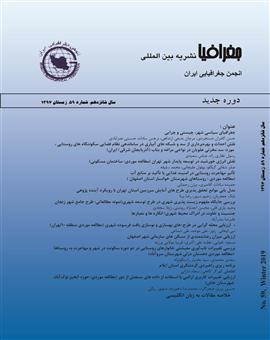ارزیابی محله گرایی درطرح های بهسازی و نوسازی بافت فرسوده شهری (مطالعه موردی منطقه 10تهران)
محورهای موضوعی :علی موحد 1 , علی شماعی 2 , نبی اوهانی زنوز 3
1 - دانشگاه خوارزمی
2 - دانشگاه خوارزمی
3 - دانشگاه خوارزمی
کلید واژه: ارزیابی, بافت فرسوده, محله گرایی, هویت محله ای, منطقه10 تهران,
چکیده مقاله :
محله گرایی و پایداری محله های شهری به پایداری اجتماعی، اقتصادی، زیست محیطی وحکمروایی خوب شهری منجر می شود. مهمترین اصول و معیارهای های محله پایدار شامل؛ مشارکت، سرمایه اجتماعی، انسجام فرهنگی، امنیت، هویت شهری، کاهش مصرف انرزی، سرزندگی و پویایی است. محله گرایی در شهرهای ایرانی- اسلامی از پیوندهای قومی، مذهبی و اقتصادی و اجتماعی ساکنان آن نشأت گرفته است. طرحهای توسعه شهری از جمله طرحهای بهسازی و نوسازی شهری در محلات فرسوده از جمله طرح هایی هستند که می تواند دارای تأثیر مثبت یا منفی، بویژه موجب گسست ساختار و سازمان محله و محله گرایی گردد. ما در این پژوهش به ارزیابی تغییرات شاخص های محله گرایی در طرحهای بهسازی و نوسازی بافت فرسوده شهری در منطقه 10 شهرداری تهران پرداخته ایم. این پژوهش بر اساس هدف کاربردی و از روش تلفیقی اکتشافی- تحلیلی و تحلیل محتوا استفاده شده است. نتایج بدستآمده مشخص می سازد، باتوجه به اجرای طرحهای بهسازی و نوسازی بافت فرسوده شهری ازلحاظ ساختاری و کالبدی که نتایج چشم گیری در منطقه موردمطالعه داشته اند؛ اما از لحاظ تأثیرگذاری این طرح ها بر ساختار اجتماعی و احساس تعلق مردم به منطقه و هویت محلی ضعیف عمل کرده و در بعضی موارد موجب کاهش سرمایه های اجتماعی و حس تعلق مردم به محل زندگی و گسست ساختار و سازمان فضایی محلات شده اند. موفقیت این طرح ها ازلحاظ اجتماعی آنچنان چشم گیر و موفق-آمیز به نظر نمیرسند و موفق به تقویت بنیان های محله گرایی نشده اند. بهطورکلی طرح بافت فرسوده شهری هماهنگی لازم بین راهبردها و سیاستهای طرحهای بالادستی و پایین دستی یا طرح های اجرایی را برآورده نکرده است.
The neighborhood has a special place in Iranian cities and is one of the elements that plays a key role in shaping collective identities. However, the body shapes the city, but beyond it, it repeats the role played in the daily lives of the inhabitants and plays a role in long-term collective memory. They become elements of identity that change in these structures can make fundamental changes to the foundations of the identity of a city. However, today, the neighborhood is no longer of importance and credibility, but with respect to the remaining historical nuclei of the old neighborhoods, it continues to identity in some areas. Urban development plans such as renovation and renovation projects of textiles and worn out sites are among the most important designs and tools that can have a positive or negative impact on neighborhood structures and neighborhood. The purpose of this study was to investigate the impact of urbanization and renovation projects on urbanization in district 10 of Tehran municipality. The present research is based on the applied objective and based on the descriptive-analytical method. The data gathering method was documentary and field study (in the form of a questionnaire, interview). Descriptive statistics (frequency, mean, ...) and inferential statistics (correlation, multivariate regression) were used to analyze the data using spss software as well as content analysis method. To this end, structural, physical, security, economic, and health indicators have been used for neighborhoodism. The results of this study indicate that, despite the fact that the implementation of urban regeneration and renovation projects in terms of structural and physical aspects has had dramatic results in the region, but the impact of these plans on the feeling of belonging to people The local area and local identity have been weak and sometimes caused the lack of trust and sense of belonging to the local community and the surrounding environment, making them unsuccessful in terms of social performance. Overall, evaluating urban drainage projects and projects has not been followed up with studies of its strategies and policies, and has not succeeded in strengthening the foundations of neighborhoodism, and it can even be said that the implementation of these plans has weakened the dimensions of neighborhood and neighborhood status in the social system. .
